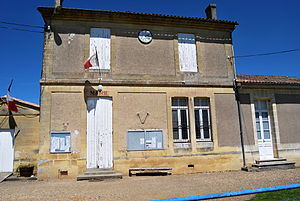Tizac-de-Curton
|
Tizac-de-Curton Tisac de Curton |
||
|---|---|---|
|
|
||
| region | Nouvelle-Aquitaine | |
| Department | Gironde | |
| Arrondissement | Libourne | |
| Canton | Les Coteaux de Dordogne | |
| Community association | Libournais | |
| Coordinates | 44 ° 49 ′ N , 0 ° 15 ′ W | |
| height | 9-77 m | |
| surface | 3.97 km 2 | |
| Residents | 330 (January 1, 2017) | |
| Population density | 83 inhabitants / km 2 | |
| Post Code | 33420 | |
| INSEE code | 33531 | |
 Mairie Tizac-de-Curton |
||
Tizac-de-Curton ( Occitan Tisac de Curton ) is a southwestern French community with 330 inhabitants (at January 1, 2017) in the department of Gironde in the region Nouvelle-Aquitaine .
location
The place Tizac-de-Curton is about 16 kilometers (driving distance) to the south of Libourne and about 15 kilometers to the southwest of Saint-Emilion ; he is at a height of about 60 meters above sea level. d. M. The city of Bordeaux is located about 30 kilometers to the west.
Population development
| year | 1962 | 1968 | 1975 | 1982 | 1990 | 1999 | 2006 | 2017 |
| Residents | 228 | 201 | 219 | 261 | 309 | 297 | 282 | 330 |
In the 19th century the community usually had between 250 and 350 inhabitants. The phylloxera crisis and the increasing mechanization of agriculture led to a gradual decline in the number of inhabitants in the second half of the 19th and in the first half of the 20th century, to the lowest level in the 1880s. Due to the relative proximity to the city of Bordeaux and the significantly lower property prices in the country, there has been a slight increase in the population over the past few decades.
economy
Tizac-de-Curton lived for centuries from agriculture, which also includes viticulture, which today occupies the largest acreage in the municipality and is marketed through the appellations of Bordeaux (AOC) , Bordeaux Supérieur (AOC) and Entre-deux-mers (AOC) becomes. But tourism in the form of renting holiday apartments ( gîtes ) also contributes to the municipality's income.
history
Some local researchers see the origin of the place name in the Latin place name Titiacum , which can be traced back to the Roman or Gallo-Roman name Titus . In the Middle Ages, the place belonged to the manor ( seigneurie ) of the Château de Curton, a good kilometer to the south .
Attractions
- The late Romanesque parish church of Notre-Dame dates from the 13th century; the age of the vestibule is controversial as the column drums and capitals appear to have been reused. The small, laterally curved bell gable and the pyramidal accompanying turret date from the Baroque period . The portal itself has no capital , which indicates a late period of construction (14th / 15th century). The apse was provided with a late Gothic rib vault in the 15th century , which rests on older Romanesque walls; the nave with its original side consoles (photo → weblink) is barrel vaulted . Church construction has been recognized as a Monument Historique since 1925 .
- The Château de Curton ( 44 ° 48 ′ 43 ″ N , 0 ° 15 ′ 4 ″ W ) is now on the territory of the neighboring municipality of Daignac .
literature
- Le Patrimoine des Communes de la Gironde. Flohic Éditions, Volume 1, Paris 2001, ISBN 2-84234-125-2 , pp. 788-789.
Web links
Individual evidence
- ^ Tizac-de-Curton, Église Notre-Dame in the Base Mérimée of the French Ministry of Culture (French)

